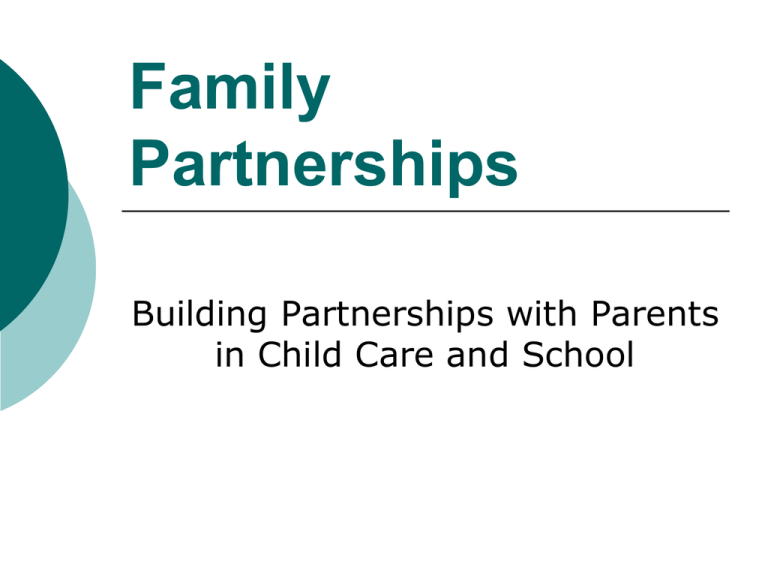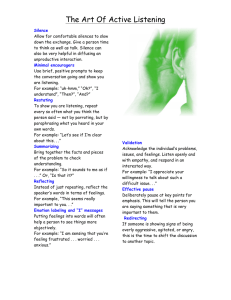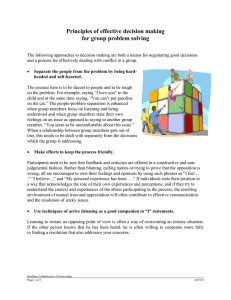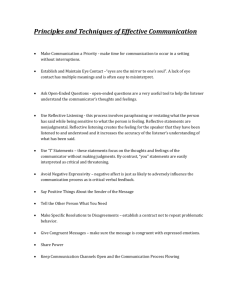Family Partnerships Building Partnerships with Parents in Child Care and School
advertisement

Family Partnerships Building Partnerships with Parents in Child Care and School Framework for Family, School and Community Partnerships There is a critical need for: Family-like schools School-like families Community-minded families Family-friendly school and communities Family Centered Approach In a family-centered approach, the concern of the center is on the child AND his parents. Emphasis is family support and services The premise is that strong, healthy, productive parents will engender those same traits in the child. Focus on partnership on behalf not just of child but of the family Innovative methods to increase interactions are encouraged, such as classroom telephones, personal family visits, journaling, and others. The center becomes a community focal point for family activities Family-Centered Care The family should be viewed as the primary teachers and caregivers of children. Staff do whatever they can to support the parents in this role. Good parent-staff communication Providing services for parents that assist them in their role. Benefits of Teacher-Family Partnerships Children Families Security in new environment Sense of self-worth Knowledgeable, consistent responses Support Knowledge and skills Teachers Feedback Enriched learning experiences Barriers to Family Partnerships Teacher Reluctance Parent Reluctance Power Issues Trust Teacher Attitudes Conducive to Family Partnerships Concept of Professionalism Sense of Self Humility Compassion Respect for Others Trustworthiness Elements in Successful Family Involvement Programs Written policies Administrative support Training Joint partnership approach Two-way communication Networking Evaluation Joyce Epstein’s Six Types of Parent Involvement Parenting: Assisting families with parenting skills Communicating: have effective homeschool and school-home communications Volunteering: Organize volunteers to support school Learning at home: Involve families with children in homework and other activities Decision-making: Include families as participants in school decision and develop parent leaders Collaborating with the community: Coordinate resources and services for families and provide services to community Group Activity Red One thing I worry about as a teacher establishing a partnership with a parent Orange One idea that can be successful in dealing with a difficult parent Yellow A form of written communication that works with parents Brown A positive memory of your parent or another parent being involved in the classroom or school Blue A form of verbal communication that has worked well with parents. Green One way to assist non-English speaking parents in being involved. What are policies? Policies are the basic rules and ideas that govern your care of the children and your dealings with parents. It includes information about your business, the way you work with the children, what you expect from parents. Forms for Parents Policies Homework Policy Planner Sample Procedures Emergency Forms Medical Forms Policy Handbooks and Websites Small Fries Child Care: http://www.smallfrieschildcare.com/page5.html Elementary: http://www.friscoisd.org/admin/docs/15476060809.pdf Pasar http://www.pisd.edu/parents/program.pasar/index.shtml Middle School: http://www.friscoisd.org/schools/fowler/documents/MicrosoftWord-FMSSTUDENTHANDBOOKADDENDUM.pdf High School: http://www.friscoisd.org/admin/docs/111635050809.pdf Building Partnerships Communicate both verbally and written Listen Carefully Show interest in family Respect Differences Provide resources Encourage involvement Maintain confidentiality Communications Basic Be warm and sincere Smile a lot!!!!! In writing: Make things in color Put in a graphic but not too much! Put borders on material VERBAL COMMUNICATION Orienting parents and children Open house Welcome call Telephone Parent centers Parent volunteers and involvement Get-togethers for classes Home visits Parent visits to room Parent/staff meetings Parent bulletin boards Regular conferences/goal setting Positive Phone Call Opportunities Before first day of school to introduce self When student performs positive behavior When child applies himself in special way When student shows improvement When student is absenf for more than a day or two Active Listening Listen to verbal and nonverbal Reflect back Paraphrase Focus on the speaker and listen Show interest by your body language and chair arrangement Look at communication other than words Reflective Listening Convey understanding and clarify meaning by: • • • • Clarifying: “I don’t understand what you mean. Please explain that again.” Paraphrasing or restating: “This is what I think you mean. Is that the idea?” Reflecting feelings: “You seem to feel . . . Am I right about that?” Summarizing main ideas and feelings: “Here is what I’ve heard you say so far.” Practice Reflective Listening You are a first grade teacher and a Mom (or Dad) has just come in upset because her child came home with her new dress with mud on it because Joey, a very active playmate, pushed her down. Use reflective listening: • • • • Clarify: “I don’t understand what you mean. Please explain that again.” Paraphrase or restate: “This is what I think you mean. Is that the idea?” Reflect feelings: “You seem to feel . . . Am I right about that?” Summarize main ideas and feelings: “Here is what I’ve heard you say so far.” Communicate through Correspondence Say Hello in a Letter Information about your professional background Your personal interests (hobbies, travels, etc.) Your educational plans and special activities for the upcoming school year A Statement expressing your confidence in the success you expect for all your students. Weekly Communication Folders What to Tell Parents About the Folder Their child will bring this folder home weekly. You will include a brief update about what the class has been studying. The folders will include student work samples. To encourage parents to comment on their children’s work, let them know that you will include a space for parent replies. Written Communication Samples Candid-Grams Teacher-Parent Telegram Parent Appreciation Station Volunteer Helping Hand What to Say When You Call About a Problem Begin with a statement of sincere concern. Describe the specific behavior that necessitated the call. Describe steps you have taken to solve the problem. Get information from the parent. Present your solutions to the problem. Express confidence in your ability to address the problem. Plan for follow-up contact. Cultural Influences on Children and Family Behavior Interest in and concern over children acquiring skills by a certain age Sleep patterns and bedtime stories Children’s role and responsibility in the family Toilet training Diet and mealtime behavior Discipline and child guidance methods How parents talk to children and how children talk to parents How parents show affection Importance of gender identity and traditional sex roles Dress and hair care Concept of cleanliness Illness and use of medicine or folk cures and remedies Use of supplementary child care Acceptance of crying Child’s attachments to adults/separation from adults Celebrating Differences Believe in Children’s Ability to Achieve: Make them feel comfortable in the classroom and figure out a way to communicate if they speak a different language (make picture boards, learn a few words of their language). Involve Families: Get to know the family, invite them in, plan multi-cultural events (where they won’t feel out of place), at no cost and at hours they can attend. Invite families in to share part of their culture (food, clothing, objects, practices, etc.). Ongoing Communication: When there is a language barrier with parents, it is easy to stop communication all together. Arrange for someone to interpret if there is a language barrier. Send information home regarding the program and the child’s activities. Home Visits: These help the teacher see the child in a more personal way and contributes to the understanding of customs and beliefs. Visits should be brief (no more than 30 minutes) and should be arranged ahead of time. Talk to Children About Differences: Introduce differences in all children and allow them to ask questions regarding these. Explain differences in non-judgmental, respectful ways. Explore different customs and cultures through activities. Live with Diversity: Incorporate music, languages (in spoken and written form), real materials, literature and customs in the daily experiences of the children that will increase awareness and appreciation of diversity as a natural part of our being. Vary center family activities to appeal to diverse population Handling the Angry Parent Remain calm: Try to keep your cool. Diffuse the situation: Ask the parent to calm down a little or at least get out of earshot of the children. Ask them if they would like to go somewhere and talk (do not go alone or close door to an office or conference room if you feel they are volatile). Use reflective listening: You may be able to help them calm down through understanding. After listening to what they say, try to check your facts and label their feelings. Ask for clarification. Set up future meeting or conference: This may not be the most constructive time to talk. Follow-up the next day: Even if your meeting is not this day, call or make sure you talk with them and ask how they feel about the situation now. What do you do in volatile situations? PROTECT YOURSELF: Don’t do it alone Use physical barriers Call the police Remember your priority: Your safety and the child’s safety. Problem Solving Behavior: Parent is rude and noncommunicative Possible Causes: Parent feels insecure and fearful about teachers and schools in general. Stress related to job, family. Intervention: Make a home visit. The parent needs to communicate on her home ground. She needs reassurance that the teacher is friendly and understanding and has a genuine interest in her child. She needs to know that the staff will be non-judgmental. Continue to greet warmly. Share short comments about child’s day. Problem-Solving Behavior: Parent is always late. Possible Causes: Parent has no or inadequate transportation. Parent is asked to work overtime frequently. Intervention: Facilitate the formation of car pools, provide bus information, introduce parents living near one another. Problem solving Behavior: Family of different ethnic origin is not at all involved in program. They do not talk to staff or respond to or return forms. Possible Causes: Parent does not speak English. Center uses one method in discriminating information. Such as: note in child’s bag. Intervention: Contact a bilingual friend or community organization in your neighborhood and schedule a home visit or conference with the parent. Brush up on key words in the parent’s native language. Hand deliver forms and explain need. Problem Solving Behavior: Parent seems disinterested in child. She never greets him or asks him about his day. The child is dropped off and picked up without ceremony. He is neat, but not always clean and often seems hungry. Possible Causes: Parent has too many personal problems to pay attention to child, pay bills, or attend to other details of life. Parent working two jobs. Cultural influences. Intervention: Be understanding a supportive. Give parent information on community resources and support groups (or start a parent support group at your center). Be accepting of her feelings and do not become defensive. Parent Conferences Types of parent conferences Beginning of the year Follow-up Conferences when there are problems Guidelines What are your goals for the conference? Parent Conference Planning Sheet Sample Comfortable, quiet setting Have assessments, examples of work, daily log Start with a positive note on child Share specific information on all areas of development Pause to allow parents to share Be honest Summarize Develop goals and strategies Follow-up During Conference Stop talking Put person talking at ease Show you listen by nonverbal cues Remove distractions Empathize Be patient Hold your temper Don’t argue or criticize or give advice! Have a positive beginning and ending No technical jargon Avoid being the expert: no shoulds, musts, say lots of parents find, I think, you are the expert on ______ Don’t label, no hyperactive or mentioning learning disability Avoid negative evaluations and words such as problem, behind, immature, never, can’t, slow, failing Summarize at the end Conduct a Conference! Divide into groups of 3: one person is the teacher, one the parent and one is the “coach”. The coaches job is to help the teacher with words and responses in the conference. A Kindergarten teacher is meeting at the beginning of the year with a very protective parent who feels their child is gifted and should be moved on up into first grade! A toddler teacher is meeting with a first-time parent who is very nervous that her 2 ½ year old child is delayed because he is not yet potty-trained. A preschool teacher is meeting with a parent of a child who is having some difficulty with social situations. The child is shy and quiet. How do you involve parents in classes? Use a needs assessment Offer food, transportation, child care Provide in their community or comfortable setting Provide in language or cultural context Make it interactive Open-ended discussions Honor their expertise


